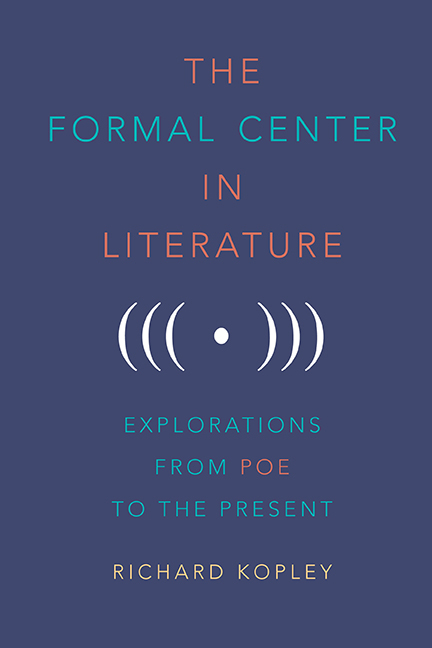Book contents
- Frontmatter
- Dedication
- Contents
- Acknowledgments
- Introduction
- 1 “Mournful and Never-Ending Remembrance” in Edgar Allan Poe's The Narrative of Arthur Gordon Pym
- 2 Retracing Our Steps in Edgar Allan Poe's “The Man of the Crowd”
- 3 “Scrutinizing the Parchment More Closely”: The Form of “The Gold-Bug” and Its Relationship to That of the Dupin Tales
- 4 Form and Reform in Nathaniel Hawthorne's “Earth's Holocaust”
- 5 The Circle and Its Center in Herman Melville's “Bartleby, the Scrivener”
- 6 Chiasmus in Henry David Thoreau's Walden
- 7 The Mythological Centers of Lewis Carroll's Alice Books
- 8 Table as Text in James Joyce's “The Dead”
- 9 The Structure of Sherwood Anderson's “Hands”
- 10 The Architecture of Ernest Hemingway's “The Three-Day Blow”
- 11 Balance in Dashiell Hammett's The Maltese Falcon
- 12 Framing Caesar in Raymond Chandler's The Big Sleep
- 13 The Ridge of the Domino in Patricia Highsmith's Strangers on a Train
- 14 The “X in the Air” in Joyce Carol Oates's “Where Are You Going, Where Have You Been?”
- 15 The Hybrid Center of Zadie Smith's White Teeth
- Notes
- Bibliography
- Index
1 - “Mournful and Never-Ending Remembrance” in Edgar Allan Poe's The Narrative of Arthur Gordon Pym
Published online by Cambridge University Press: 14 June 2019
- Frontmatter
- Dedication
- Contents
- Acknowledgments
- Introduction
- 1 “Mournful and Never-Ending Remembrance” in Edgar Allan Poe's The Narrative of Arthur Gordon Pym
- 2 Retracing Our Steps in Edgar Allan Poe's “The Man of the Crowd”
- 3 “Scrutinizing the Parchment More Closely”: The Form of “The Gold-Bug” and Its Relationship to That of the Dupin Tales
- 4 Form and Reform in Nathaniel Hawthorne's “Earth's Holocaust”
- 5 The Circle and Its Center in Herman Melville's “Bartleby, the Scrivener”
- 6 Chiasmus in Henry David Thoreau's Walden
- 7 The Mythological Centers of Lewis Carroll's Alice Books
- 8 Table as Text in James Joyce's “The Dead”
- 9 The Structure of Sherwood Anderson's “Hands”
- 10 The Architecture of Ernest Hemingway's “The Three-Day Blow”
- 11 Balance in Dashiell Hammett's The Maltese Falcon
- 12 Framing Caesar in Raymond Chandler's The Big Sleep
- 13 The Ridge of the Domino in Patricia Highsmith's Strangers on a Train
- 14 The “X in the Air” in Joyce Carol Oates's “Where Are You Going, Where Have You Been?”
- 15 The Hybrid Center of Zadie Smith's White Teeth
- Notes
- Bibliography
- Index
Summary
ONE OF THE MOST interesting centers of a literary work is that of Edgar Allan Poe's novel The Narrative of Arthur Gordon Pym (1838). As I've noted, it was the first literary center I found, and it led, eventually, to this book.
Poe's adventurous sea narrative comprises twenty-five chapters, and the central one of these, chapter 13, is a two-week journal (July 24 to August 7) containing twenty-two paragraphs. The August 1 entry—the eleventh paragraph—is the center. It richly illuminates the autobiographical import of the novel.
The voyage to the south has, at this point, involved secret stowage, mutiny, counter-mutiny, hurricane, the Flying Dutchman, and cannibalism. In chapter 13, Pym's friend Augustus Barnard is dying from a wounded arm that has mortified. In the critical central paragraph, Augustus dies. The essential language is as follows:
August 1 A continuance of the same calm weather, with an oppressively hot sun…. We now saw clearly that Augustus could not be saved; that he was evidently dying. We could do nothing to relieve his sufferings, which appeared to be great. About twelve o'clock he expired in strong convulsions, and without having spoken for several hours.
This passage subtly conveys one of the tragedies of Poe's life. While the protagonist Arthur Gordon Pym corresponds to the author Edgar Allan Poe—the rhythm alone is suggestive—so does Pym's friend Augustus Barnard correspond to Poe's brother Henry. Both are tall and slender, tellers of tales of travel, and given to drink. Pym is two years younger than Augustus just as Poe was two years younger than Henry. Both Augustus and Henry were sick, and both died as young men on August 1. The central passage in Pym is Poe's representation of the death of his brother—a death he may well have witnessed. After all, until his brother's death in 1831, he and Henry were living with their Aunt Maria Clemm and her mother, her son, and her daughter Virginia, in a small apartment in Baltimore. Probably Edgar and Henry shared the same room—maybe even the same bed.
Symmetrical language frames this dramatic center.
- Type
- Chapter
- Information
- The Formal Center in LiteratureExplorations from Poe to the Present, pp. 13 - 18Publisher: Boydell & BrewerPrint publication year: 2018



